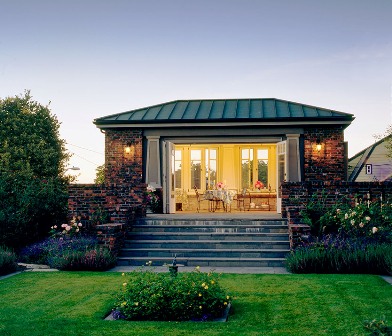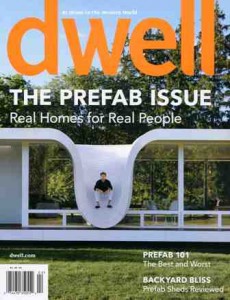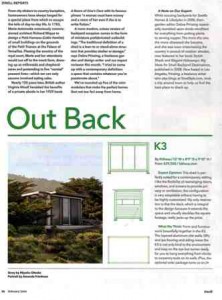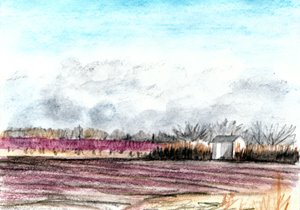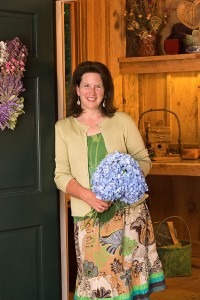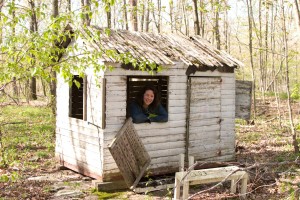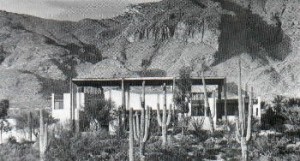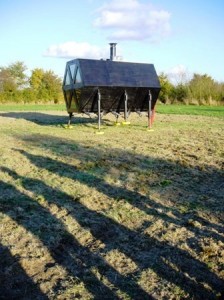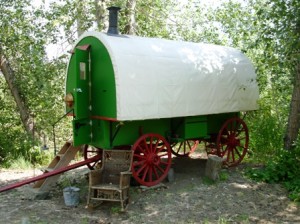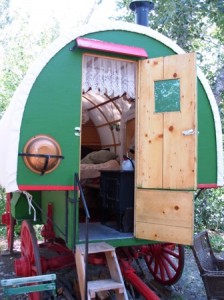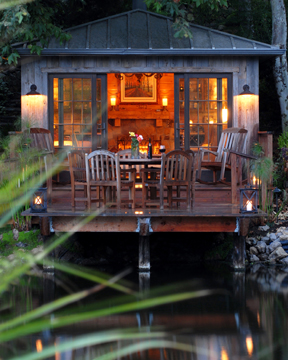
Last Friday, I enjoyed a wonderful “field trip” to Church Estates Vineyard in Malibu, owned by Robert Church Haggstrom. This was one of those magical behind-the-gates visits that reminds me how very fortunate I am to be a writer in this town.
I was invited by publicist Dienna D’Olimpio, with whom I’ve been corresponding for a few months. She originally contacted me to share photographs and background info about Church Estates Vineyard, its chateau and garden settings. I haven’t even tasted the wine yet (the winery’s first Chardonnay will be bottled soon and its Pinot will be ready this fall), but the beauty of the setting appealed to me immediately.
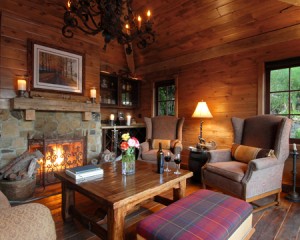 A tiny building, situated at the edge of a pond, captured my imagination. I later learned that Bob calls it his “boathouse,” and to me, it is the most beautiful, romantic boathouse I’d ever seen. Truly an elegant hideaway. (see interior, right).
A tiny building, situated at the edge of a pond, captured my imagination. I later learned that Bob calls it his “boathouse,” and to me, it is the most beautiful, romantic boathouse I’d ever seen. Truly an elegant hideaway. (see interior, right).
Once I saw photographs of the gardens (not to mention the boathouse), all of which share the nine acres with 3,000 grapevines, I knew I wanted to visit and develop a story.
The estate is available for weddings, corporate events, and other private parties. Robert Church Haggstrom’s personable daughter, Maja, is the go-to gal for brides, corporate event planners, and anyone else who wants to rent the lovely haven for an unforgettable day.
As impressive as are the vineyards and well-appointed chateau, I couldn’t take my eyes off of Bob’s little getaway by a pond. The boathouse photos – seen above – are courtesy of Church Estate Vineyards.
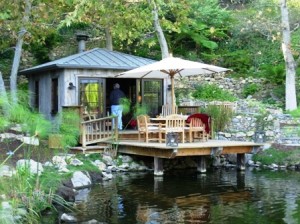 Dienna arranged for me to visit and I managed to persuade my husband, Bruce, to come along for the tour. He’s not really into gardens, but he is into real estate. We drove to Malibu, about 30 minutes from home, and arrived at Church Estates in time to meet Maja just inside the entrance. Thank goodness she was driving a golf cart because the elevation change from the parking area (near a sunken clay tennis court and horse stables) to the upper gardens and chateau would have required sturdy shoes and perhaps a walking stick to navigate on foot.
Dienna arranged for me to visit and I managed to persuade my husband, Bruce, to come along for the tour. He’s not really into gardens, but he is into real estate. We drove to Malibu, about 30 minutes from home, and arrived at Church Estates in time to meet Maja just inside the entrance. Thank goodness she was driving a golf cart because the elevation change from the parking area (near a sunken clay tennis court and horse stables) to the upper gardens and chateau would have required sturdy shoes and perhaps a walking stick to navigate on foot.
We hopped onto her golf cart and made our way up the winding drive, through the garden, to the grand French-style chateau. Out of the corner of my eye, I spied the pond and boathouse. The table on the dock was set for lunch! Oh, goodie, we were going to end up there at the water’s edge for our meal.
Maja narrated our tour: She grew up in Malibu and knows the ins and outs of every square inch of Church Estate Vineyards. To listen to Maja describe the gardens here, you can tell she still has that childlike wonder and curiosity about nature’s beauty. It is infectious.
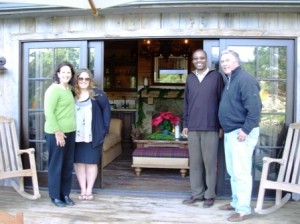 The story of Church Estate Vineyards is one that I will tell in a future article, after I spend a proper amount of time with “Malibu Bob,” as Mr. Haggstrom is affectionately called around here.
The story of Church Estate Vineyards is one that I will tell in a future article, after I spend a proper amount of time with “Malibu Bob,” as Mr. Haggstrom is affectionately called around here.
But in the meantime, I will touch on highlights of his boathouse.
- It was the first thing he built here after purchasing the property five years ago
- Bob wisely situated the structure at the bottom of the hill, nestled under a stand of mature sycamore trees – facing the man-made pond, which he has since landscaped and stocked with swans.
- The boathouse measures about 20-by-20 feet in size; the exterior is finished in weathered wood and the standing-seam metal roof is aging nicely.
- The interior features a lovely fireplace and comfy furniture (but not a bed, darn it! Bob said he figured if there was a bed, all of his guests would argue over who would get to sleep here)
- The floor is made from antique boards, and when one of Bob’s friends accidentally knocked over a container of oil (after a fondue party), Bob decided to have the entire floor rubbed with oil – which adds a soft, aged patina to the space.
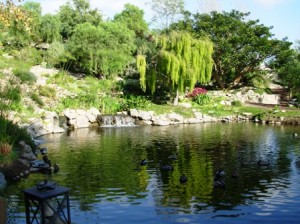
Thank you Bob, Maja, Marie and Dienna – we had a wonderful visit, enjoyable conversation, delicious food — and were thoroughly enchanted with the magical setting you’ve created at Church Estate Vineyards. I can’t wait to return!
[photo above, from left: me, Maja, my husband Bruce Brooks, and Robert Church Haggstrom].
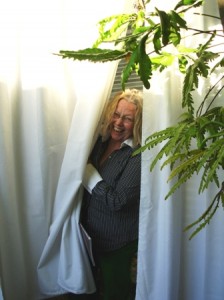 Literary agent Charlotte Gusay has a delicious secret. She recently shared it with me and gave me permission to write about it here.
Literary agent Charlotte Gusay has a delicious secret. She recently shared it with me and gave me permission to write about it here.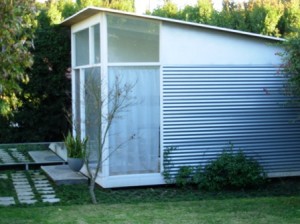 This irresistible 10-by-14 foot haven is tucked comfortably into a far corner of Charlotte’s urban lot, hidden from everyone’s view but hers. Because of the way it has been sited, the shelter is first seen “in profile,” its longer side and angled shed roof-line emphasized. When glimpsed by newcomers (such as Paula and me) the shed reveals its see-through quality, thanks to a wraparound glass “corner” that connects two outer walls. The white-painted framework around the windows and door outlines and emphasizes vertical and horizontal lines of the design (almost Mondrianesque in its geometry).
This irresistible 10-by-14 foot haven is tucked comfortably into a far corner of Charlotte’s urban lot, hidden from everyone’s view but hers. Because of the way it has been sited, the shelter is first seen “in profile,” its longer side and angled shed roof-line emphasized. When glimpsed by newcomers (such as Paula and me) the shed reveals its see-through quality, thanks to a wraparound glass “corner” that connects two outer walls. The white-painted framework around the windows and door outlines and emphasizes vertical and horizontal lines of the design (almost Mondrianesque in its geometry).









